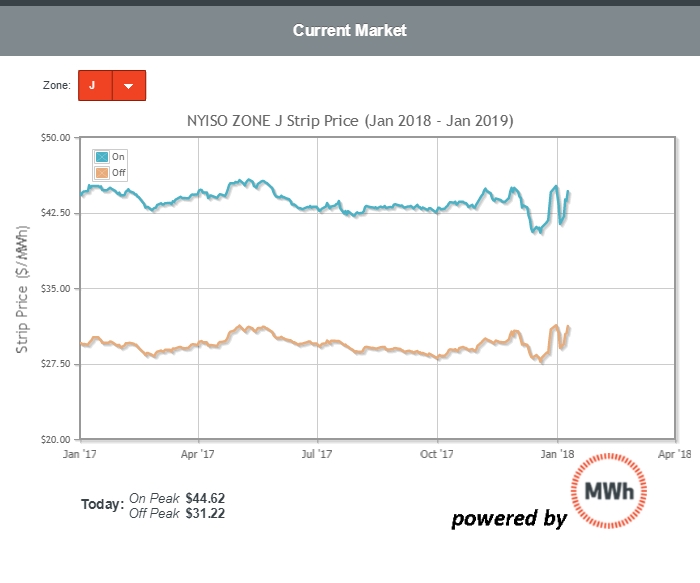Volatility has returned to energy markets for the first time in 3 or 4 years. We are only 12 days into the New Year, but it has already been a bumpy ride for energy markets. The cold weather that has periodically hit the country since the end of December sent power and gas markets into a series of turbulent phases. In fact, in late December, New England was the world’s most costly gas market, according to Bloomberg.
Cold weather has impacted index markets as well as forward markets. In this post, we will show you what has occurred in forward markets over the past two weeks.
On Monday, we will provide you with a view of index market volatility.
How volatile is volatile?
Forward markets transitioned from being essentially dormant (and reaching 12 month lows) around the 22nd of December to achieving recent highs just a week later. For definitions of forward markets and an idea of the importance of energy markets to your costs, look at MWh’s Resources.
Take a look at the following graph which depicts the forward curve for NYC (Zone J) for on and off peak power. The following graph tracks how the forward curve has changed over the last year for the same strip of power (January 2018 – January 2019).

What does this graph mean?
Note the trough during the mid to end of December, the significant increase in prices (on a relative basis) with the onset of cold weather, and now another recent increase in prices for this strip of power. So, a customer who was interested in purchasing a power or gas contract for the next calendar year could have paid as little as $0.06/kWh on December 22. That same 12 month term and same volume would have cost the customer $0.066/kWh (a 10% increase) if the customer made the purchase just a week later.
Why did this volatility occur during the cold weather?
Why do natural gas costs impact electricity pricing? Over the last 7 to 10 years, there has been a significant shift in the fuels that supply power plants. Environmental regulation and the discovery of significant natural gas resources within the US have driven a shift from powering plants with coal to burning natural gas to generate electricity. Natural gas is also a significant heating fuel. When cold weather hits, transportation of gas and, in some cases, gas supplies can get constrained. (This all started back in 2014 when the so-called “polar vortex” occurred.) As a result, we see greater price volatility when cold weather sets in than we ever have before. Markets have transitioned to winter peaking price-wise, even though the highest demand for electricity continues to occur in summer.
For background on what drives natural gas prices, take a look at this article titled Natural Gas: Background.
How bad is it, doc?
The truth is that there is a solid supply of natural gas in North America. The US has recently become a net natural gas exporter for the first time in 60 years (which may bring high prices and greater volatility down the road). The market began this run at all time lows. So while the relative increases look significant, we still are operating in relatively low cost markets. In addition, even though we’ve seen volatility, there is a fast return to calm once cold weather subsides. So there is no cause for panic. But it always pays to be both vigilant and slightly paranoid about the potential for market run ups.
Why should you care about energy volatility?
Bottom line for energy and finance decision makers: When you choose to engage in energy markets matters to you, your colleagues and your CFO. Having a window into the dynamics of markets and how they change will impact what you pay. Make sure you have ready access to information on forward markets.
Up next: How has this weather impacted shorter term index markets?
